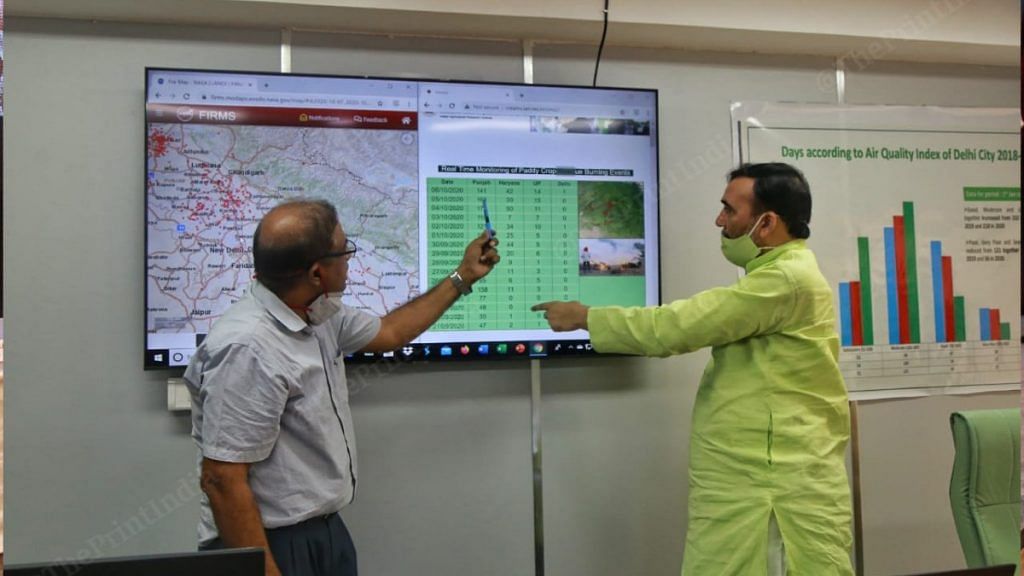New Delhi: The Delhi government launched a ‘Green War Room’ Thursday to aid its battle against the pollution crisis that envelops the national capital, among other parts of north India, every winter.
The war room will serve as a nerve centre for the efforts of different agencies working to tackle air pollution in the national capital, and track status of complaints received through a mobile app, Green Delhi, to be launched soon.
Its responsibilities also include analysing satellite data related to farm fires from Punjab and Haryana — the fires are believed to be among the primary drivers of the smog that leaves Delhi breathless every year and at the top of global pollution charts.
The Green War Room is just one of several steps taken by the Aam Aadmi Party (AAP) government in Delhi to spell some relief for Delhiites this winter.
Earlier this week, Chief Minister Arvind Kejriwal launched a ‘Yuddh Pradushan Ke Viruddh (war against pollution)’ campaign that will include, among other things, an intensive anti-dust drive, installation of anti-smog guns, and an action plan for the 13 pollution hotspots in Delhi.
The steps are more important than ever, with experts suggesting that exposure to endemic air pollution may be the reason why cities like Mumbai and Delhi have been among the worst hit by Covid-19.
After a brief respite during the Covid-19 lockdown, the national capital Wednesday woke up to its ‘poor’ air quality day of the season, with the air quality index (AQI) hitting 207, according to the Central Pollution Control Board (CPCB).
Here are some of the highlights of Delhi’s proposed war against pollution.
Also Read: Delhi air clean in lockdown but high pollution seen for few hours after dawn — JNU-DU study
Coordination with other states
Farmers in Haryana and Punjab clear out their land for winter sowing by burning the stubble left over from the monsoon paddy harvest. The plumes of smoke rising from the ensuing fires are believed to be among the primary drivers of smog in Delhi.
This year, Delhi will be spraying crop residue with a solution developed by the Indian Agricultural Research Institute, Pusa, that can reportedly decompose and convert it into manure. “If the technique is found to be useful, we can ask other states to implement it to prevent stubble burning,” the CM said Monday.
The Delhi government has also requested Punjab and Haryana to come up with alternatives to stubble burning and offer them to farmers for free.
Identifying pollution hotspots
The Delhi government has identified 13 hotspots — where the level of pollution is higher than other areas — in order to identify the source of pollution. These hotspots include industrial areas, as well as those where waste burning, road dust and traffic congestion are a particularly frequent. They are Okhla Phase-II, Dwarka, Ashok Vihar, Bawana, Narela, Mundka, Punjabi Bagh, Wazirpur, Rohini, Vivek Vihar, Anand Vihar, R.K. Puram and Jahangirpuri.
Tree transplantation policy
CM Kejriwal announced this week that he will very soon approve a ‘Tree Policy’ aimed at increasing the green cover in Delhi. The draft Tree Policy, which was put in the public domain in February 2019, has preservation and transplantation of trees as its main focus areas.
Talking about the policy, Kejriwal said it will ensure that 80 per cent of trees affected by projects are transplanted, or extracted from an area where a certain construction/road project is envisaged, and replanted elsewhere.
The government is also looking to enforce its electrical vehicle policy, which was notified this August. The policy aims to subsidise the purchase of electric vehicles in Delhi, with an aim to have five lakh electric vehicles on the road in the next five years. The idea is tackle the use of fossil fuels, which is another major factor in pollution.
Also Read: Delhi air pollution set to spike again as stubble burning begins and economy reopens
Imposing fines
Inspection teams will visit construction sites and levy heavy fines if they are found to be violating anti-pollution guidelines, which include such rules as covering trucks that carry construction material, protective gear from workers, and a licence from the Delhi Pollution Control Committee.
Municipal bodies in Delhi will also make use of mechanical sweepers to tackle road dust.
Green Delhi app
CM Kejriwal announced Monday that a mobile app called Green Delhi will be launched in the coming days to encourage public participation in the battle against pollution. Anyone in Delhi who witnesses a source of pollution — vehicular, industrial or otherwise — can click a photograph and post it on the app. The Green War Room, as mentioned before, will track the status of complaints registered under the app, with Kejriwal promising personal oversight.
Also Read: Delhi and Mumbai’s high Covid tally linked to severe air pollution levels, say experts
